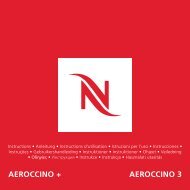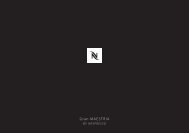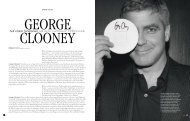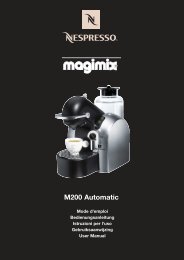Executive summary - Nespresso
Executive summary - Nespresso
Executive summary - Nespresso
You also want an ePaper? Increase the reach of your titles
YUMPU automatically turns print PDFs into web optimized ePapers that Google loves.
Focus on packaging<br />
Comparative LCA of B2C espresso capsules<br />
Figure 0-2 shows that if only the packaging production and its end-of-life are considered, the<br />
<strong>Nespresso</strong> Espresso recycling scenario has lower GHG emissions impacts than the generic<br />
product 1 or 3 Espresso (since the latter is a mix between starch and PLA) for all end-of-life<br />
routes; and lower impacts than the generic product 1 for all end-of-life routes except for DFS<br />
where it has similar impacts (note that DFS end-of-life route does not exist at the moment for<br />
the generic product 2 Espresso).<br />
The results have been tested with extensive sensitivity and uncertainty analyses showing<br />
that the conclusions are robust and the underlying assumptions and data uncertainty do not<br />
significantly influence the conclusions. Some limitations apply to this study and should be<br />
communicated along with the results (including that the coffee production was considered<br />
identical in all products and that the conclusions apply only to the systems studied and are<br />
not general statements about materials environmental performances).<br />
Conclusion<br />
The <strong>Nespresso</strong> Espresso product, when capsule is sent to recycling, is the alternative<br />
among the investigated alternatives that has the lowest overall environmental impacts<br />
(significant for GHG emissions, resource consumption and human health, while ecosystem<br />
quality and water use show similar impacts between <strong>Nespresso</strong> Espresso recycling and<br />
others best scenarios) 1 .<br />
An eco-design process should consider improvement potentials on the entire life cycle<br />
(notably coffee supply and use stage) and not only on the packaging aspect.<br />
These conclusions are about product systems with specific design and not about the various<br />
materials used to produce the capsules.<br />
1<br />
Note that differences in the total impacts are not significant for the generic product 2 capsules sent to DFS and<br />
<strong>Nespresso</strong> capsules sent to recycling when distribute<br />
on is excluded. The distribution contains some uncertainties, but its impact is lower for <strong>Nespresso</strong> than for the<br />
generic product 2, and when included it creates a slight advantage for <strong>Nespresso</strong> sent to recycling compared to<br />
the generic product 2 sent to DFS. However, considering uncertainties and current data, the difference in overall<br />
environmental impacts between <strong>Nespresso</strong> sent to recycling and the generic product 2 Espresso sent to DFS is<br />
considered not significant<br />
Quantis Sàrl - Parc scientifique EPFL Bât D, 1015 Lausanne, Switzerland<br />
TEL +41 (21) 693 91 92 - FAX + 41 (21) 693 91 96 | info @quantis-intl.com - www.quantis-intl.comS<br />
7










